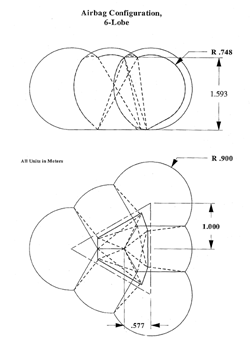
The Mars Pathfinder airbag system was designed to protect the lander regardless of its orientation upon impact with the surface of the planet. The system also was designed to handle lateral movement as well as vertical descent.
The result is a robust system capable of landing in rugged but scientifically interesting locations at Mars. Development of the airbags required significant design and test work, but the qualification program for the system was completed in April of 1996, 8 months prior to launch.
See how the airbag system fits in the entire Entry, Descent and Landing process.

Each airbag is configured as six, 0.9 m radius spheres spaced on 1.0 m centers. Internal and external straps or tendons hold the airbag to the lander at six locations.
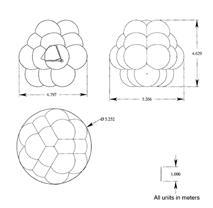
The airbags are made out of a high strength fiber called Vectran. They are constructed with an airtight bladder layer surrounded by four layers of a slightly lighter Vectran fabric. The multiple layers of a lighter weave was found to work better than a single layer of a heavier weave of Vectran. Sandia National Laboratory helped JPL do the early design and analysis of the airbag concept. ILC Dover, Inc. built and tested the airbags.

Shown here during retraction testing, an engineering model 8-wheel rover is in the foreground.

The Space Power Facility (SPF) at NASA's Lewis Plum Brook Station (part of NASA's Lewis Research Center) is the world's largest vacuum chamber. The airbags and lander were dropped in this facility in order to simulate martian atmospheric pressures (1/100 of Earth's). The photo shows the airbags suspended 20 feet above an impact platform just prior to door closing.

The airbags were dropped onto a flat platform from 30 and 70 feet to test their performance. Catch nets surround the platform to contain the airbags when they bounce. The test was a giant slam dunk! It worked great!
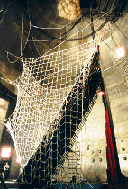
After testing on a flat, smooth platform, engineers made things tougher by raising the platform to a 60 degree angle and placing rocks on its surface. In order to get the airbags and and lander (about 800 pounds total) up to nearly 60 mph for the tests, engineers had to invent and build a giant bungie cord accelerator. The bungie cords pulled on the lander with about 2000 pounds of force, and only releasing when the assembly hit the platform.
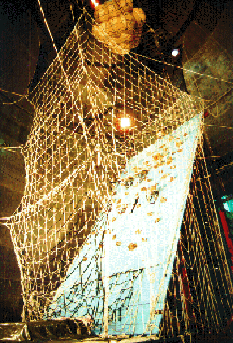
Giant, energy-absorbing catch nets were necessary to catch the lander and airbags after they hit the platform at 60 mph. The top of the platform stands nearly 50 feet high.
 |
 899K |
The black markings on the airbags were used to help see what was happening in the high speed film taken of each test. The slot in the center of the platform is where the bungie accelerator tow line passed through. The large rocks (supported with steel backing) stand 1 m high. They were all hand picked by a JPL planetary geologist to represent the closest match to actual Mars rocks. (And they were very sharp and nasty!)

This is a close-up view of a medium-sized hole (about 12 inches long) torn in the airbags during drop testing. Early testing resulted in multiple, large (18-24 inch long) tears in the fabric. As you can see, the airbags are constructed of a relatively thin bladder surrounded by a heavy-duty outer abrasion layer.

ILC Dover technician Eleanor Foraker repaired the airbags after each test. Four complete airbag systems were built for testing. Stiching dozens of layers of this nearly bulletproof material was never easy, but always necessary. Eleanor was also the woman who sewed Neil Armstrong's and Buzz Aldrin's moonsuits for the Apollo 11 mission!

Sixteen drop tests were performed under different conditions and with many different types of abrasion layer constructions. Here the airbags are shown during the rigorous inspection done after any repair work. After each test, engineers and technicians meticulously inspected every stich and seam in the airbags and documented any damage.

Engineers in the control room cheer after a successful test!

ILC Dover engineers installed the airbags into very tight bundles around the test lander in preparation for a high speed inflation test. Extremely precise packaging of the airbags was necessary in order to balance properly the whole spacecraft and to make sure the airbags unfolded correctly when they were deployed.

With casings made out of titanium, three gas generators built by the Thiokol Corporation are used to inflate the airbags. The airbags go from being stowed to fully inflated in less than 1 second. This "explosive" inflation is done by using solid rocket propellant in the gas generator. The exhaust byproducts of the rocket fuel inflate the airbag. Thermal heaters can be seen on two of the three gas generators above.
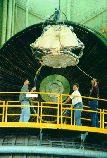 |
 868K |
Here, a completely packaged lander with airbags and gas generators installed, is lowered into a test chamber to perform a high speed inflation test. Before inflating the airbags, the chamber was cooled to -80degC using liquid nitrogen. Nearly all the air was also removed from the chamber. Once the airbags cooled, the gas generators were ignited and the airbags inflated.
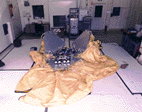
Retraction tests were performed to make sure the airbag fabric could be pulled out of the way before the lander was opened. In this picture you see the lander with a rover on it, partially opened. In the foreground in the airbag fabric partially retracted. Tiny, high-strength cables and a miniature winch inside the airbag are used to perform the retraction.
Back to the Mars Pathfinder Home Page